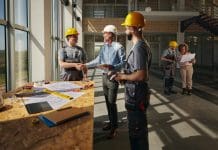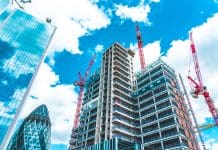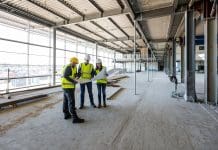The construction industry needs to come together to build a greener future, says Gillian Charlesworth, chief executive of BRE Group
The Covid-19 crisis is undoubtedly a challenge for our sector but it also presents an opportunity to accelerate the changes many in our industry agree we need. Let us not waste it. The economic stasis brought on by measures designed to limit the transmission of the virus has led to a period of reflection soon followed by a rapid call to action: how do the construction and built environment sectors recover in a transformative way?
The recent roadmap drawn up by Construction Leadership Council (CLC) is full of thoughtful proposals. With a long-term ambition to deliver better value, through collaboration and partnership, the plan carefully balances safety and productivity. It also outlines how improving the sustainability and resource efficiency of our industry is fundamental in our quest to achieve net-zero by 2050.
The roadmap’s approach to building a better future is very much in BRE’s DNA, with our organisation having been at the forefront of construction innovation since 1921. As a partner in the government-funded Construction Innovation Hub, we are playing our part in some of the greatest challenges in history.
Decarbonising buildings
It is increasingly understood that buildings currently account for 40% of the UK’s carbon emissions. Since most carbon emissions in the built environment come from energy use, the simplest step in addressing the problem is by reducing consumption through energy efficient design. This is a core part of BRE’s work, and our team of experts has an extensive track record of working with developers to reduce the environmental impact of construction processes, materials and operations, as well as providing information and benchmarking on all aspects of the sustainability of buildings.
Sustainability needs a holistic, societal approach, embracing not only decarbonisation but also the homes shortage, the need for greater resilience, tackling poverty and ill heath, addressing the requirements of our ageing population, and ensuring reforms to our planning system deliver. The CLC plan laid out sustainability-focused approaches that maximise value to all involved – owners, occupants, shareholders and society as whole – while minimising impact on the environment.
The different drivers and levers of change are growing in number and impact. Building on the government’s net-zero target, it’s great to see lenders placing increasing weight on lending on development and property with increased efficiency and lower running costs – thus incentivising developers to incorporate innovative solutions into their stock. The finance sector – through the Green Finance Initiative – is putting a great deal of work into identifying financial instruments the market could provide to enable and drive change.
The Green Homes Grant – which was revealed in the Chancellor’s summer statement – should be available for homeowners from September 2020. Encouragingly, the scheme will involve a “whole house approach”, through which a retrofit specialist will determine the measures to ensure the best value for money for the owner – and the taxpayer – in the home. Sensible actions to help boost the economy like this are welcome and it’s reassuring to see the government placing such emphasis on housebuilding and the wider property sector, through a firmly ‘green’ lens, given the sector’s importance to the economy and the deeper, longer-term challenge of achieving net-zero.
Influencing change
Influence is crucial among those who want to see this change. Leaders in the built environment continue to explore ways they can make a difference. With the climate crisis coming into sharp relief as both a threat and an opportunity, the time is now for the construction industry to be more prominent and guide the green recovery. Multifaceted solutions are required. Building on the CLC’s roadmap, we need greater collaboration – within industry and with government – and a suitable regulatory landscape that upholds the highest standards, while also fostering innovation. This combination will be fundamental in achieving greater and more rapid decarbonisation and improved safety. New skills will be needed to drive performance and implement new methods.
At a more personal, individual level, it has been said many times, but we need our homes to be places that people want and communities welcome. In the last few months, many of us will have been giving much thought to the way our homes and other buildings we spend time in might be affecting our health and wellbeing. BRE has seen an increase in enquiries to our air quality monitoring and testing team. This focus on wellbeing and safety can only be positive for individuals and businesses, as we improve living and workplace standards from both health and productivity perspectives.
I frequently feel when talking or writing about these issues that the points I’m making are rather obvious. I think they are, but I am also acutely aware, particularly in the midst of the current global crisis, that the goal of net-zero carbon may seem as elusive as ever and, to some, irrelevant in a crisis.
We need practical solutions. The CLC roadmap shows a route through and the recently published Construction Innovation Hub Value Toolkit provides solutions and a direct response to the increasing conditionality government is placing on development, starting with the public sector. Supply chains are galvanising, new skills are being developed and our stakeholders’ expectations and demands are changing. While the scale of the challenge is vast, the opportunities are becoming visible and the momentum to act is palpable.

Gillian Charlesworth
Chief executive
+44 (0)333 321 8811
Twitter: bre_group














